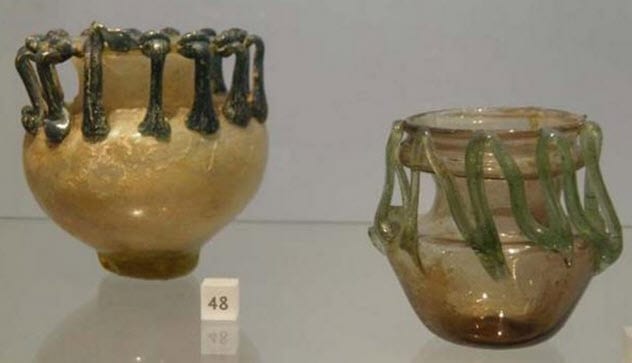 Music
Music  Music
Music  History
History 10 Less Than Jolly Events That Occurred on December 25
 Weird Stuff
Weird Stuff 10 Funny Ways That Researchers Overthink Christmas
 Politics
Politics 10 Political Scandals That Sent Crowds Into the Streets
 Weird Stuff
Weird Stuff Ten Bizarre Facts About The Doge Meme
 Our World
Our World 10 Ways Your Christmas Tree Is More Lit Than You Think
 Movies and TV
Movies and TV The 10 Coolest Stars to Set Sail on The Love Boat
 History
History 10 Things You Didn’t Know About the American National Anthem
 Technology
Technology Top 10 Everyday Tech Buzzwords That Hide a Darker Past
 Humans
Humans 10 Everyday Human Behaviors That Are Actually Survival Instincts
 Music
Music 10 Surprising Origin Stories of Your Favorite Holiday Songs
 History
History 10 Less Than Jolly Events That Occurred on December 25
 Weird Stuff
Weird Stuff 10 Funny Ways That Researchers Overthink Christmas
Who's Behind Listverse?

Jamie Frater
Head Editor
Jamie founded Listverse due to an insatiable desire to share fascinating, obscure, and bizarre facts. He has been a guest speaker on numerous national radio and television stations and is a five time published author.
More About Us Politics
Politics 10 Political Scandals That Sent Crowds Into the Streets
 Weird Stuff
Weird Stuff Ten Bizarre Facts About The Doge Meme
 Our World
Our World 10 Ways Your Christmas Tree Is More Lit Than You Think
 Movies and TV
Movies and TV The 10 Coolest Stars to Set Sail on The Love Boat
 History
History 10 Things You Didn’t Know About the American National Anthem
 Technology
Technology Top 10 Everyday Tech Buzzwords That Hide a Darker Past
 Humans
Humans 10 Everyday Human Behaviors That Are Actually Survival Instincts
Top 10 Ideas That Were Far Ahead Of Their Time
Sometimes, an idea is so brilliant that it changes the world immediately. Sometimes, it takes a little longer. In fact, a great concept may take millennia to catch on.
So don’t be too disappointed if your genius notion doesn’t impress people straightaway. It’ll get there even if you’re no longer around to see it. Here are 10 ideas that were way ahead of their time.
10 World-Famous Ideas That Started As Dreams
10 Unbreakable Glass

Glass is an excellent invention. Not only is it good for storing food and drink, it can also be decorated to make a luxury item. Discovered around 3600 BC in Mesopotamia, glass was only found in the hands of the elite at first. Given its fragility and the difficulty of its production, glass seemed destined to remain an expensive and rare material.
One invention may have changed that, however. According to Pliny the Elder, an inventor presented himself to Roman Emperor Tiberius with a curious discovery. The clever man had invented an unbreakable, flexible form of glass.[1]
In another account, Tiberius was given a new glass cup that was pretty but nothing special in his estimation. After Tiberius handed it back to the inventor, the glassmaker threw the cup on the floor. To the emperor’s astonishment, it was not smashed but merely slightly dented. Surely, the man was made for life?
In a sense, he was. But it was not a long life.
Apparently, Tiberius was concerned that this discovery would destroy the value of silver and gold, so he had the inventor beheaded. While Pliny thought this story was unlikely, some researchers believe the man may have invented an early form of the shatterproof borosilicate glass used today.
9 Atoms

What happens if you take a piece of cake and cut it? You get two smaller bits of cake. What if you slice it again? And again?
For most thinkers in the ancient world, there was no end to the amount of cutting you could do. No matter how much you sliced, there was always a smaller piece of cake—like a terribly disappointing birthday party. But to Democritus and Leucippus, there was an “uncuttable,” smallest piece of cake. The Greek for “uncuttable” is atomos, from which we get the word “atom.”[2]
According to these philosophers, atoms come in a variety of forms. By mixing these different types of atoms, all visible matter is created. Today, we might call these mixtures molecules. Despite being first postulated in the fifth century BC, the existence of atoms was still doubted by some people even at the end of the 19th century AD.
There were even hints of quantum theory in the ancient world. According to Epicurus, atoms moved in straight lines when nothing was acting on them, but they occasionally “swerved” at random.
8 Vending Machines

If we come up with one good idea in a lifetime, then most of us would be satisfied. But there are some lucky people who are just brimming with genius.
Heron of Alexandria was one of those individuals whose every idle thought seems to have been a stroke of inspiration. Living in the first century AD, he invented many things that would not be seen again for nearly 2,000 years.
One of his first ideas brought science and religion together in a very pleasing way. Holy water has long been a feature of religious worship. In the ancient world, you had to pay for this water. But even under the eyes of the gods, some people would steal more than they paid for. Heron was on the case, however.[3]
He created the first vending machine. A worshipper deposited a coin into a slot, and this moved a lever that opened a pipe. Then the water flowed out. Once the coin fell into the machine, the water stopped. Every worshipper got the water he paid for, and the temple received all the money it was due.
7 Automatic Doors

Seven of the books written by Heron of Alexandria still exist, and they are full of amazing inventions. Some of his ideas were designed to seem miraculous. Although we associate automatic doors with shops, Heron hoped to startle worshippers when he created automatic doors for a temple.
In Heron’s design, the doors of the temple would not open when just anyone approached. They would only open when a fire was lit on an altar. The heat of the fire warmed the air held in the hollow altar, and the expanding air drove water into a bucket. The heavy bucket pulled on a rope and opened the doors.[4]
Today, we might be more impressed by automatic doors if we had a priest light a fire and chant as we walked toward the doors.
6 Steam Power
Heron was not satisfied with religious tricks. One of his inventions might have truly revolutionized the world. The industrial revolution of the 18th century in Europe could have happened hundreds of years earlier if Heron’s steam-powered inventions had taken off.
Heron understood that water expands when it is turned into steam. He created an object called the aeolipile from a hollow ball and a few pipes. By producing steam and forcing it out of the pipes, the hollow ball would spin rapidly. Heron had invented the first steam engine.[5]
Unfortunately, the aeolipile remained a mere curiosity and was largely forgotten.
10 Supposedly Good Ideas That Backfired
5 Contact Lenses

Pairs of glasses worn on the face to help people see were first used in Italy in the 13th century. As all individuals who wear glasses can tell you in this age of face masks, there are drawbacks to wearing glasses on your nose. Wouldn’t it be much simpler if you could just pop the lenses into your eyes?
In 1508, Leonardo da Vinci wrote a treatise that described how plunging your head into water changes how you see. He came up with funnels tipped with lenses and filled with water that could be attached over the eyes. They were not practical.
Rene Descartes thought of a simpler version. Why not fill a glass tube with water and attach it straight to the eyeball? These lenses would have been the first to be directly in contact with the eye. Unfortunately, they would also have stopped you from blinking.[6]
To improve Descartes’s design, Thomas Young reduced the length of the glass tubes so that the eyelids could close. But to get them to stay in place, he did have to use wax to stick them to the eyebal . . . Contact lenses were a good idea, but technology just had not caught up.
4 Underfloor Heating

Fires are romantic things. On a winter night, it is lovely to sit and watch one. But they are incredibly inefficient at heating a home.
Most of the heat goes up the chimney. Those close to the fire can be burned on the parts near the fire and freezing on their backs. The Romans were not ones to let this inefficiency stand—they invented a method of centrally heating their homes.
When they built their villas, they first created a hollow space under the ground. These spaces were supported by tiles with large gaps between them.
Known as hypocausts, these structures allowed hot air to pass through them. A fire was channeled into the hypocaust, and the hot air warmed the home from below. The air was also drawn through channels in the walls. So the whole home was warmed and not just the parts near the fire.[7]
When the Roman Empire collapsed, hypocausts went out of fashion and Europe became a much chillier place to live for hundreds of years.
3 Flushing Toilets

Toilets are always a good idea. Contact with human waste is one of the best ways to catch a nasty illness, so trying to move sewage away from where you live should be obvious.
For most of human history, the best that someone could do was wander a little way from his home to use a toilet that was little more than a hole in the ground. Often, the toilet in the home was just a pottery vessel that had to be emptied into the street.
In 1700 BC in the Minoan Palace of Crete, toilets were created that used running water to carry away the sewage. This incredible palace may have been the first place to have flushing toilets.
Communal toilets with long banks of seats and running water remained in existence for centuries, but we would have to wait for the modern flushing toilet to come into the home. And the invention of soft toilet paper.[8]
2 Computer
In 1822, Charles Babbage presented a paper to the Royal Astronomical Society in London. Called “Note on the Application of Machinery to the Computation of Astronomical and Mathematical Tables,” it was nothing less than his idea for a mechanical computer.
At the time, long calculations were made easier by having hefty tomes filled with tables of mathematical results. To avoid errors in these vital tables and to do them faster than humans, Babbage had invented a machine to do repetitive calculations.[9]
Babbage’s difference engine would have been a marvel. Made from 8,000 parts cast in bronze and weighing five tons, this hand-cranked contraption would have churned out all the mathematical results you could ever want. It even printed out the answers of the calculations fed into it.
Unfortunately, the difference engine was never completed. Despite the astronomical amount of £17,000 given to him by the British government, Babbage was unable to build a working model.
It was only in the 1990s that Babbage’s designs were actually made. Like the answers churned out by his machine, it turned out that Babbage had calculated correctly—his difference engine would have worked.
1 Computers (Again)
Charles Babbage’s metal calculating machine was not the first of its kind, but it took researchers some time to work this out. After corroded and encrusted lumps of metal were pulled from an ancient shipwreck off the coast of Antikythera in 1900, historians were puzzled by what they might be. These green fragments would have to wait until they were probed with X-rays to reveal their secrets.
The Antikythera mechanism, as these fragments were named, consisted of at least 30 metal cogs that had been housed in a wooden box. The device was made around 100 BC.
The interlocking wheels were marked with symbols that could be read by the user and used to calculate the positions of the Sun, Moon, and planets. By turning the wheels, you could get the mechanism to tell you what the heavens would look like on any given night.
Some of the dials were marked with balls representing the heavenly objects they tracked—for example, a golden Sun and a red Mars. The mechanism could even predict lunar and solar eclipses.[10]
Nothing else like the Antikythera mechanism has ever been found. Ancient writers hint at objects that could model the night sky, but these items seem to have been completely lost from history. Perhaps other ancient inventions lie at the bottom of the sea just waiting to surprise us.
10 Lucrative Ideas Sold For Almost Nothing








